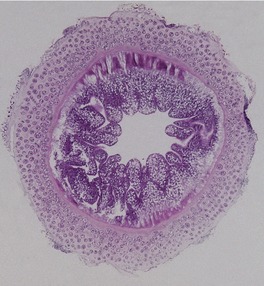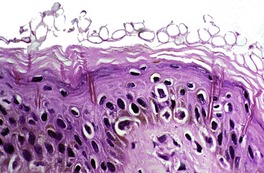Introduction642
INTRODUCTION
CNIDARIANS
Histopathology

Fig. 28.1

Fig. 28.2
MOLLUSCS
ECHINODERMS
SPONGES
SEAWEED
![]()
Stay updated, free articles. Join our Telegram channel

Full access? Get Clinical Tree


Marine injuries
Cnidarians642
Molluscs643
Echinoderms643
Sponges643
Seaweed643
Venomous fish643
There have been several reviews of the cutaneous manifestations of marine animal injuries,1.2.3. and 4. including Fisher’s Atlas of Aquatic Dermatology. 5 Although of great dermatological and medical interest, these cutaneous lesions are of little dermatopathological importance. Biopsies are rarely taken, and, if they are, the findings, with several exceptions, are not diagnostically or etiologically specific.
In the brief account that follows, various categories of marine organisms will be considered.
Although the phylum Cnidaria, formerly Coelenterata, has over 9000 species, fewer than 80 are of clinical significance.2.3.4. and 5. The toxic effects of cnidarians (coelenterates) result from contact with the nematocyst, a coiled thread-like tube, found particularly on the tentacles, which pierces the skin on contact. The toxin contained in the nematocysts of some species is capable of producing such diverse reactions as erythema, urticaria, a burning sensation, or, rarely, fatal anaphylaxis and cardiorespiratory arrest. 6 The cnidarians of dermatological or medical importance include the Portuguese man-of-war7 (Physalia physalis) in the class Hydrozoa, the box jellyfish8 (Chironex fleckeri) in the order Scyphozoa, and the corals in the order Anthozoa.
More than 70 deaths have resulted from the sting of the box jellyfish. 8 In the areas of contact with the tentacles, linear erythematous and urticarial lesions are produced. These may persist for several days or longer, and be followed by postinflammatory pigmentation or keloid formation. 9 The jellyfish Stephanoscyphus racemosum Komai, also known as ‘Iramo’, and found in Japanese waters, can produce hemorrhagic bullae after contact with its nematocysts. 10
Attention has also been given to the development of delayed and recurrent eruptions, not necessarily at the previous site of contact, which may follow solitary episodes of envenomation by different species of cnidarians.9.11.12.13. and 14. An immunological mechanism has been postulated for these delayed or recurrent reactions.13.15. and 16.
In the case of corals the nematocysts are relatively innocuous, but some coral cuts are slow to heal. Localized persistent inflammatory reactions have been reported at the site of contact with coral. 17
Seabather’s eruption is a highly pruritic maculopapular eruption, under swimwear, that occurs after bathing in the ocean. 18 It appears to result from the nematocyst of a cnidarian larva; 18Edwardsiella lineata and Linuche unguiculata have been implicated.19.20. and 21. Ghost anemone dermatitis, produced by Haloclava producta, also a member of the class Anthozoa, produces a similar dermatosis to seabather’s eruption, although vesiculation often occurs as well. It is found along the US East Coast and Gulf of Mexico. 22 They should be distinguished from ‘swimmer’s itch’, which occurs primarily in fresh water and is caused by schistosomal cercariae (see p. 646). 23 Paresthesias and pruritus, particularly in the axillae, groins, and genital region, can result from contact with Liriope tetraphylla medusa, from the class Hydrozoa. It forms a bloom in the shallow waters of the South American Atlantic coast. 24
A biopsy from the site of contact with the tentacles of jellyfish (Fig. 28.1) will show nematocyst capsules in the swollen stratum corneum. 25 There is some thinning of the malpighian layer, with focal pyknosis of nuclei. With reduced light, fine refractile threads, sometimes continuous with the nematocysts, can be seen penetrating for variable distances into the dermis (Fig. 28.2).25.26. and 27. The threads are further highlighted with a reticulin stain.
A box jellyfish tentacle in cross-section. (H & E)
The site of a box jellyfish sting. Nematocysts are present above the stratum corneum. Several fine thread-like tubules penetrate the epidermis. (H & E) (Photograph kindly provided by Dr G Strutton)
In some of the recurrent eruptions produced by cnidarians a heavy dermal lymphocytic infiltrate may be present.12.13. and 28. Spongiosis of the overlying epidermis is sometimes present. 29 Rare reactions include granulomas, papular urticaria, local necrosis, 30 and subcutaneous atrophy. 11 Atypical CD30+ lymphocytes have also been reported in a delayed reaction to a Red Sea coral injury. 31 Rarely, corals can produce an inflammatory reaction which on biopsy shows the pattern of a persistent arthropod reaction or papular urticaria. 17
In seabather’s eruption there is a superficial and deep perivascular and interstitial infiltrate of lymphocytes, neutrophils, and eosinophils.
The phylum Mollusca includes such well-known delicacies as scallops and oysters, as well as slugs, squid, cone shells, and several types of octopus. 5 Cone shell snails of the genus Conus produce a painful puncture wound if handled carelessly, followed by systemic toxic symptoms which are sometimes fatal.
There are approximately 80 venomous species among the 6000 that comprise the phylum Echinodermata. 5 This phylum includes sea urchins, starfish, and sea cucumbers, all of which possess an array of sharp or toxic spines.
Sea urchins are widely distributed in several tropical and subtropical oceans. Their brittle spines break off in the skin, where they may produce several different lesions. A neurotoxin is present in the spines of some species. There is an immediate reaction with burning pain, followed by edema and erythema. Small nodules may develop several months after the injury. The resulting dermal reaction has been reported as sarcoidal granulomas, 34 although the illustrations suggest non-caseating tuberculoid granulomas.34. and 35. One study found granulomas of sarcoidal, tuberculoid, suppurative, necrobiotic, and foreign-body types in 39 biopsies with granulomas. 36 A foreign-body granulomatous reaction, probably to the debris of a spine, has been observed. 37 Implantation cysts may also form. 34 Sea-urchin spines have been removed by erbium:YAG laser ablation. 38
A contact dermatitis can result from contact with certain starfish and sea cucumbers. 4
Several species of sponge can produce a contact dermatitis, and the spicules from some may produce a foreign-body reaction if implanted in the skin. 5 A severe vesicular dermatitis can occur in some people who come in contact with the ‘fire sponge’, Tedania ignis. 39 It has been suggested that the reaction may be a primary irritant one, and not a contact allergic reaction. 39 An erythema multiforme-like reaction has also been reported which developed 10 days after the contact. 39
The marine alga Lyngba can produce an acute dermatitis characterized by intraepidermal vesiculation. 40 An allergic contact dermatitis can be produced by a completely different species, Alcyonidium diaphanum, a member of the phylum Bryozoa, which produces a seaweed-like animal colony known as the sea chervil or Dogger Bank moss.5. and 41. These sea ‘mosses’ are found on the Dogger Bank and give rise to a pruritic vesiculobullous dermatitis (‘Dogger Bank itch’) in fishermen who come into contact with them. 5 It is an allergic contact dermatitis to a sulfoxonium ion, a metabolite produced by the organism. 42






